Proiecte
Proiecte Internaționale
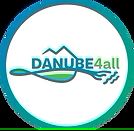
Europe’s rivers are congested. More than a million barriers, like dams, ramps and fords, are causing extensive loss of river connectivity. In addition, human interventions have ecologically degraded a whopping 70 to 90 % of Europe’s floodplain. Despite ambitious EU policy to turn things around, fresh and transitional water ecosystem restoration remains limited. The EU-funded DANUBE4all project will develop a comprehensive restoration action plan for the Danube River basin lighthouse. The project will engage stakeholders, integrating citizens’ interests to support the EU Mission ‘Restore Our Ocean and Waters by 2030’ in an unprecedented cocreation process. The action plan will rely on solid scientific knowledge and new findings to promote ecological status, biodiversity, and ecosystem connectivity improvement.
The project focuses on two domains – Inland Water Management and Ecosystem and biodiversity monitoring, because these two domains are related, also making it easier for end-users to use the results.
Furthermore, relevant guidelines, regulations, and governmental strategies already integrate the two domains. This applies for example to the Green Deal, the European Water Framework Directive, and the EU Biodiversity strategy for 2030.
The project will have three test sites: Forth catchment in the United Kingdom, Volkerak-Zoommeer in the Netherlands and the Danube Delta in Romania.
Using a bottom-up approach, the project addressed the local stakeholders engaged in different sectors of the maritime economy across all EU regional seas aiming to gather examples of greening traditional ongoing business or to help start new green ones. This approach included questionnaires and open interviews addressed to industry bodies and associations, port authorities, small and medium-sized enterprises, NGOs, etc. These actions aimed at learning from successful examples, with a view to creating a portfolio of relevant information to replicate the successful examples elsewhere in the EU, as well as to learn from the unsuccessful examples (understanding/knowing the factors that led to their failure). To increase the relevance of the result for MSFD implementation, the identified examples were characterised according to the type of environmental pressure they address – the pressure generated by fishing, presence of marine litter, changes in the hydrographic conditions, pollution (including noise), etc. Based on this information, the project identified the ways in which regional, national and EU policies could enable and support such activities. The main objective was to explore the knowledge and experience of the economic actors involved in order to make the maritime economy greener in a profitable way, either by introducing innovative techniques/ products or by changing the way economic operators operate in different maritime sectors.
- In December 2013, the EU adopted the work program for the joint implementation strategy (CSI WP) of the MSFD for the period 2014-2018. The joint implementation strategy aims, among other things, to address the shortcomings and drawbacks of the first phase in terms of coherence and comparability of its implementation by Member States within and between the marine regions. The activities highlighted for the Black Sea region were: 1) review of the GES definitions and environmental objectives; 2) development of a joint monitoring program; 3) improvement of common understanding and scientific knowledge on some specific descriptors; 4) development of tools to facilitate the exchange of information, reporting and public participation; 5) development of a coordinated Program of Measures ; 6) improving links with existing and new instruments under other Directives; 7) taking into account the possible role and involvement of the Regional Seas Conventions and EEA.
- During a meeting organized by the European Commission to discuss the recommendations in the evaluation reports referred to the Article 12, focused on regional level, Romania and Bulgaria agreed to work together to improve the adequacy and coherence of the implementation of the MSFD. In 2014, the Commission established that continued support would be needed to make significant progress in the Black Sea. Bulgaria and Romania agreed to start by reviewing and developing coherent GES definitions, environmental objectives and identifying common indicators. The two EU countries also agreed to develop coordinated action programs taking into account the work carried out under the supporting project Arcadis contract – phase I and the Bucharest Convention, as well as to take into account joint measures whenever possible.
- The purpose of the contract was to support Bulgaria and Romania in developing joint and/or coordinated measures to be taken into account in the development of their national program of measures.
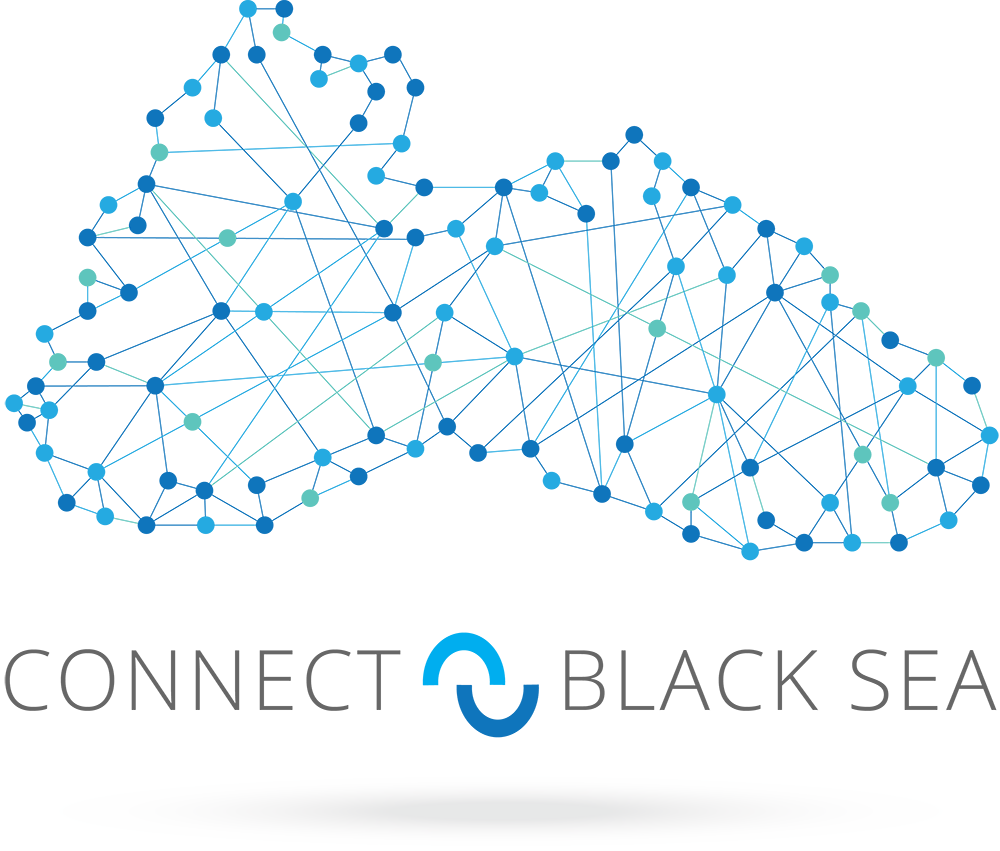
The future of the Black Sea is a key priority for the European Union. The Burgas Vision Paper issued in May 2018, under an initiative supported by the European Commission, outlines the key framework to ensure the sustainable development of the Black Sea by 2030. It focusses on the creation of a Strategic Research and Innovation Agenda (SRIA) based on the identification of critical research problems. The 2019 “Bucharest Declaration” of the scientific community launched the Strategic Research and Innovation Agenda (SRIA) for the Black Sea. Black Sea CONNECT is a key H2020 Coordination and Support Action (CSA) which addressed the development of scientifically, technically and logistically support for the broader Black Sea Blue Growth Initiative, supported by the European Commission (EC) and composed of country-appointed experts, stakeholders and various national and international organizations.
Black Sea CONNECT was the first project in its own field for Black Sea. The initiative has strengthened connections among Black Sea countries, paving the way for long-term regional cooperation and sustainable growth.
The overall objective of the Black Sea CONNECT was to coordinate the development of the Strategic Research and Innovation Agenda (SRIA), based on the defined principles in the Burgas Vision Paper, and support the development of the Blue Economy in the Black Sea.
The SRIA and its Implementation Plan will guide stakeholders from academia, funding agencies, industry, policy, and society to address together the fundamental Black Sea challenges, to promote the blue economy and its prosperities of the Black Sea region, to build critical support systems and innovative research infrastructure and to improve education and capacity building.

The project studied the lagoons, deltas and estuaries, the transitional areas between rivers and seas. Its main objective was to improve and harmonize methods of studing surface waters by using satellite data and in-situ measurements. CERTO investigated water parameters used to assess the quality status of all transitional aquatic environments. The project provided services that could be used by environmental quality monitoring agencies, by those working in the field of environmental policies, by various private companies, as well as by the general public. The main result of the project was a system ready to be implemented in the Copernicus services or in other specific softwares.
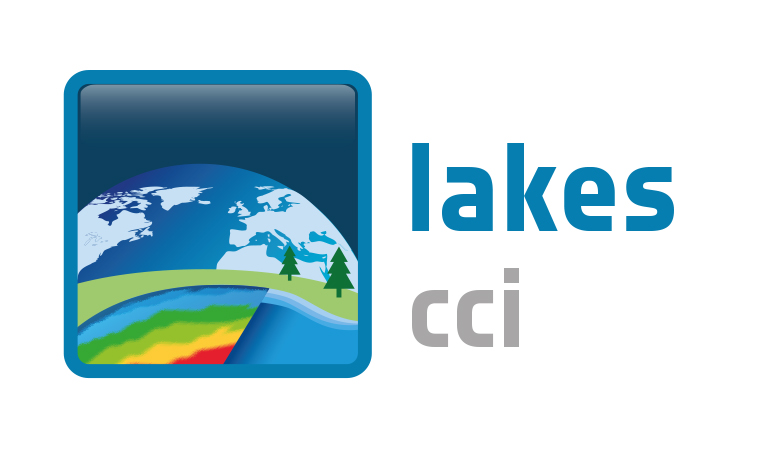
The CCI Lakes project consisted of producing and validating key variables for the assessment of the effects of climate change in lakes around the world and is part of the European Space Agency’s initiative to study climate change. These variables were: water temperature and water level, water extent, ice cover and water colour. Variables were obtained through satellite data from the 1990s to the present day and had constituted the most time-extensive databases of this kind. The first sets of variables, obtained within the project, were published in 2020 for a set of over 250 lakes.

The DOORS Research and Innovation Action developed an optimised open research support system for the Black Sea to: (1) address human and climate change impacts on its fragile and damaged ecosystems and (2) support real behavioural change across its complex geopolitical and governance landscape for Blue Economy development. In doing so, DOORS provided the ambitious framework to overcome the barriers to the advancement of the Blue Economy agenda. DOORS brought together existing fragmented monitoring efforts, delivered state-of-the art observation capability, engaged stakeholders through participatory approaches and established a harmonized capacity-building framework. These outcomes maximise the benefits to all Black Sea communities to promote business growth, well-informed stakeholders and educated citizens.
The overall objective of DOORS is to make the Strategic Research and Innovation Agenda (SRIA) for the Black Sea operational, support the successful implementation of Blue Economy and contribute to a healthy, productive and resilient Black Sea. To fulfil this, DOORS embed stakeholders’ collaboration at its core and developed three Programmes:
- Programme-1 System of Systems (SoS) for the Black Sea, a platform for evidence-based knowledge development that was co-designed with policy makers and covers relevant aspects of the physical, chemical, and biological parameters of the Black Sea. The SoS enables a more holistic approach, reflecting the ecosystems services provided, and provides scientific support to the management of the Black Sea.
- Programme-2 Blue Growth Accelerator (BGA), identified sectors and entrepreneurs for innovation, provided professional support to unlock their potential, enhanced the exploitation of knowledge, and facilitated access to investors and constructive exchange between scientists, entrepreneurs and policy makers for sustainable development of Blue Economy sectors.
- Programme-3 Knowledge Transfer and Training (KTT), built upon on existing, and developed new collaborations, between the different actors on science and policy to promote a culture of openness, share best practice and knowledge. It built capacity to address impacts by engaging stakeholders from the beginning of the project to develop and sustain mutually beneficial collaboration.
DOORS is underpinned by co-development and co-creation of the research and innovation action with key actors from across the Black Sea thus having built mutual trust and understanding which ensured that stakeholder engagement was highly productive.
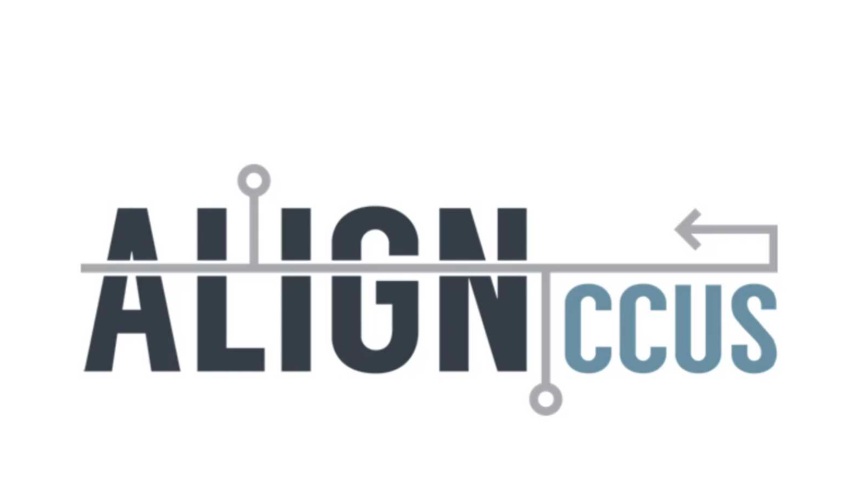
The ALIGN-CCUS project aims to accelerate the transition of current industrial and energy sectors towards a future in which economic activities generate low carbon emissions, with carbon capture, utilization, and storage (CCUS) playing a key role. ALIGN addresses specific challenges within the CCUS chain for industrial regions in ERA-NET countries, enabling the large-scale and efficient deployment of CCUS by 2025.

Land-Sea Interface: Let’s Observe Together (LandSeaLot) is a Horizon Europe project that seeks to integrate and enhance existing coastal observation efforts including in situ, satellite, modelling and citizen science to better study the land-sea interface area, where terrestrial and marine habitats meet. LandSeaLot is a four-year Horizon Europe funded project that will apply novel approaches to help achieve the goals of the EU Mission “Restore our Ocean and Waters by 2030” and the wider objectives of the EU Green Deal.The 20-partner consortium works to bring together the fragmented land-sea interface area observation communities across various scientific domains to co-design and develop an integrated, optimal, and robust observation of the land-sea interface area.
In LandSeaLot, GeoEcoMar is co-leading Work Package 2, contributing to building a Common Observation Strategy and to the long-term project’s impact and legacy. LandSeaLot Integration Labs are dynamic testing sites for developing and refining a Common Observation Strategy across land-sea interface areas in Europe. They serve as centres to test new methods and technologies, following a community-based approach to a fit-for-purpose observation of river mouths, estuaries and deltas. GeoEcoMar leads the Danube Delta LandSeaLot Integration Lab (LIL) in the framework of Work Package 5. The Danube Delta and coastal area Integration Lab is observing, mapping, analysing and modelling on coastal morphology and sedimentology, as well as plastics and nutrients pollution patterns and hotspots. These observation efforts will provide crucial data to stakeholders and policymakers and support local and regional mitigation.

The EROVMUS project aims to create an established interface for ROV (remotely operated vehicle) pilots, enabling them to easily and efficiently launch the ROV services in missions related to the identification/location of unexploded underwater munitions stranded on the seabed. These include both a multi-operational platform equipped with a series of sensors and software creating solutions. The activities envisaged are related to navigation improvement, the introduction of autonomous identification routines, as well as high-performance image acquisition technologies. The data obtained from multiple sensors will be overlaid to produce an equivalent of the standard primary Heads UP (HUD) display for the pilot, thus reducing the number of displays that is necessary for efficient operation. Furthermore, solutions for implementing virtual reality (VR) technology will be analysed, allowing the use of virtual displays and the combination of images from multiple cameras to create a single large virtual display to improve ammunition identification. The project will develop, test and optimize a range of tools and assess their interoperability with several existing ROV models and brands. This will create a potential product range that could be implemented by other ROV equipment manufacturers.
The project outcome has the potential to both improve the current technical state of the equipment and to create new jobs, thus improving the European competitiveness in the underwater technology sector.

Accelerating CCS to achieve significant CO₂ reductions by 2030 requires close integration of technical, economic, social, and environmental disciplines to support decision-making related to permitting, ensuring safe containment, and maintaining compliance during the execution phase of CCS projects. The RamonCO Project aims to further develop and fully apply the modeling/inversion framework developed in DigiMon and to assess societal challenges and requirements, as well as costs, in order to develop risk governance strategies for industry and regulators, incorporating them into decision-support tools.
The project will develop and demonstrate methodologies and tools for compliance assessment and risk-based monitoring on an industrial scale, including the analysis of operational data from sites equipped with relevant monitoring technologies. At the start of the project, we will initially test the inversion framework using synthetic data and then explore the possibility of obtaining suitable real-field data for testing the methodology with industry partners. Furthermore, we will model CO₂ storage sites that are in the planning phase, such as depleted gas fields in the Netherlands. We will also investigate how different perspectives on CO₂ storage across European countries influence risk assessment (for EU CO₂ storage hubs) and how these insights can be used to make informed decisions regarding the monitoring systems.

Recently CCS value chain started considering ships for direct injection, not only transport. The CTS project will evaluate the global potential of this technology for facilitating permanent CO2 storage using case studies from offshore on the Norwegian Continental Shelf, Baltics, Black Sea and Atlantic coast of Portugal. CTS will study the impact of direct injection from ship on the definition of capture clusters and storage facilities by developing CCS scenarios in four different offshore regions in Europe. The efficiency of the scenarios from the perspective of cost and abated CO2 emissions compared to existing plans and scenarios will be evaluated. One of the project goals is to advance direct ship injection technology further together with NEMO Maritime – the industrial partner developing one of such solutions. Direct ship injection is a flexible and low cost solution that can help accelerate CO2 storage and contribute to reducing emissions already by 2030. CTS aims at improving cost and efficiency along the value chain; developing new markets by better addressing the need of smaller emitters; increasing LCA and TEA knowledge for the value chains in selected areas. By utilizing offshore storage and building trustful communication with stakeholders in selected geographical locations, CTS also aims to contribute to strengthening the acceptance of CCUS technologies.
The main impact of the project is to provide a technology that will allow to decrease costs, reduce conflicts with other marine activities and increase flexibility for early start of CO2 injection in offshore regions, therefore addressing some of the major issues that can hinder the deployment of CCS in Europe on a scale able to deliver required mitigations before 2030.
The project aims to engage new stakeholders in four offshore regions through versatility, flexibility and cost efficiency of direct CO2 injection from ship for permanent storage. The key outcome is design of a full CCUS value chain including direct injection from ship, with engagement of the stakeholders along it. Creation of a full value chain design will promote stakeholder engagement and create a platform for evaluation of the business cases by individual stakeholders by giving them a realistic scenario to adhere to.
The outcomes should help to increase roll-out of the CCS value chains not only through technological advantages of direct ship injection, but also by reducing the threshold for smaller emitters and unlocking offshore storage potential in sites becoming commercial due to lower capex and opex of direct ship injection. Generally, CTS contribution is to map potential emitters, prepare conceptual design of the value chain with a focus on ship design, wells, and storage site.
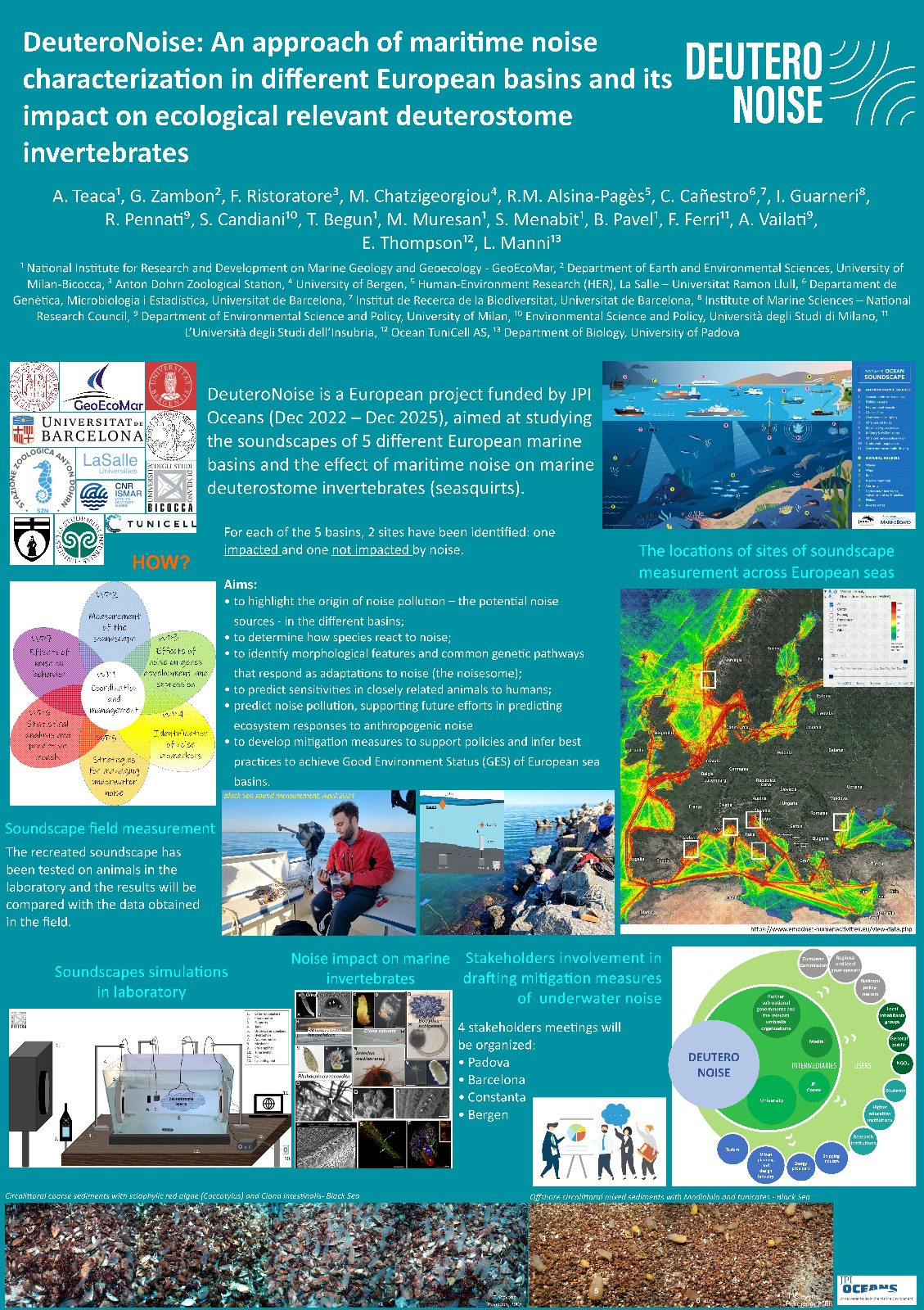
Among noise sources, maritime traffic is of relevance on animal wellness, although its impact is little known in many European sea-basins. To date, there has been an almost exclusive focus on vertebrates, in which noise involves the mechanoreceptor cells of the ear and can cause hearing impairment or deafness. Homolog cells have been discovered in tunicates, marine invertebrates closely related to vertebrates, thus opening the question on their ability to sense and be affected by noise. Tunicate mechanoreceptors sense sound waves and particle movement and are predictable targets of noise pollution. DeuteroNoise aims to characterize the noise pollution caused by maritime traffic (also using simulations) in selected sites of the North Adriatic Sea, Lagoon of Venice, North Sea, Black Sea, and Barcelona shore, and test its effects on behavior, nervous system and sensory organs, immune system, and resilience in marine invertebrates closely related to vertebrates (deuterostomes): hemichordates, echinoderms, cephalochordates, and tunicates. These animals are common in European seas and cover different levels of the trophic network, from the holoplankton-meroplankton to sessile or sedentary primary consumers. Noise level will be detected on site and simulated in the laboratory. A behavioral, morphological and genetic survey will be conducted on sampled animals living in polluted vs non-polluted areas. Moreover, animals will be exposed to noise in laboratory-controlled conditions to verify its effect on larval, juvenile and adult stages at individual level and over generations. Comparative studies will allow us to: highlight causes of noise pollution in the different basins; determine how species react to it; identify its genetic and morphological signatures; predict sensitivities in closely related animals that cannot easily be studied in laboratory or on-site; predict noise pollution and infer the best practices to reach the Good Environment Status of European basins.

Sturgeons represent highly valuable faunistic resources, constituting a significant source of income and employment in the Black Sea basin. However, threats such as water pollution, habitat destruction, illegal harvesting, and trade endanger their survival. Sturgeon populations in major basins have declined by 70% over the past century, particularly in the Danube River and its Delta. The SturNet project aims to protect sturgeon populations and conserve the unique ecosystem of the Black Sea basin. Through collaborative research, data collection, and model development, our habitat conservation efforts will support the sustainable development of the region’s natural resources. The project aims to address these issues by developing a free digital mapping tool that provides information on sturgeon behavior and migration routes.

